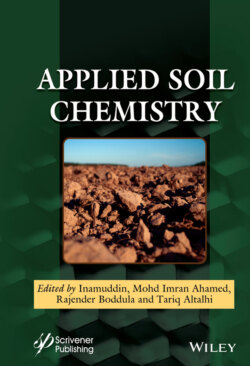Читать книгу Applied Soil Chemistry - Группа авторов - Страница 16
1.1.1 Soil Decomposition Processes
ОглавлениеAnimals that live in the soil vary from clearly visible spineless animals such as woodlice, centipedes, and earthworms, to smaller, microscopic-scale animals, the mesofauna, including mites (arthropods), springtails (Collembola a hexapod), and enchytraeidae worm-like (microdrile oligochaete) creatures. Some of the smallest animals in the soil, such as nematodes and protozoa, are among the most effective in the soil decomposition processes [15]. Soil organisms of all sizes and types collectively consume plant, animal, and bacterial debris in the soil. They do this by communition, or the reduction of material from one average particle size to a smaller average particle size, using various physical and biochemical techniques. Fungi and bacteria play a key role in breaking down the structural fabrics of plant materials. These groups are able to convert cellulose and lignin into soluble materials applying complex enzymes to do so. Subsequently, the soluble materials produced are absorbed by the organisms and further metabolized.
Initially, dead plant material located above the ground are, for the most part, decomposed above ground on the soil surface. The soil organisms, weather, and industrial-scale anthropogenic mechanical process such as ploughing, play the substantial role in initiating above-ground and near-surface soil decomposition. In some specific cases, for instance, peat formed in bogs and swamps, the dead plant substances stay at the surface of the soil without time to progress through the complete decomposition process. Instead, it becomes rapidly inhumed by other dead plant substances being added from above, isolating it from abundant oxygen supplies.
A consequence, at completion of the soil decomposition processes, is that carbon is ultimately conveyed from the decaying matter into fungi and soil bacteria. This material is known as microbial biomass. Microbes generate and use this biomass to provide their energy requirements and to create new microbial biomass for growth. That carbon used for energy is converted to CO2 and contribute to soil respiration. However, that portion of the carbon transformed into new microbial biomass, ultimately, is itself consumed or decays upon the demise of the micro-organism and contributes to the ongoing cycle of decomposition. Each successive step in the soil decomposition process involves the consumption of dead biomass by soil organisms, mainly fungi and soil bacteria. Thus, specific carbon molecules pass through many cycles of decay and ultimately end up, over time, either re-emitted to the atmosphere (soil respiration) or fixed by carbon mineralization in the subsurface. On a global scale, the amount of carbon mineralized by soil decomposition is approximately equal to the carbon arriving the soil less the amount re-emitted by soil respiration. Soil respiration returns about 60 Pg a−1 (petagram per year; equivalent to 60 gigatonnes) of carbon to the atmosphere, which is about half of the carbon entering the soil [14].
Total carbon accumulating in soils, termed as net primary production (NPP) from organic sources, varies significantly depending on local climatic conditions, vegetation zones, and ecosystems. NPP varies from about 0.5 t C ha−1 a−1 (tonnes of carbon per hectare per year) in deserts to about 4 t C ha−1 a−1 in grasslands to about 10 t C ha−1 a−1 in tropical rain-forests [14]. A direct positive relationship also exists between NPP and the magnitude of carbon released by soil respiration [16].
